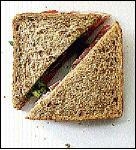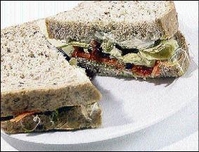Inflation fighters - All-purpose sandwiches to go (part 1)
Published: Thursday | February 5, 2009

Dispatches: Sandwiches made with whole wheat bread. Don't forget the vegetables.
As you continue to manage your food budget, there are several options for finding creative ways to feed your families. We often think of having a cooked meal instead of lighter options like sandwiches. However, sandwiches can be very filling and cost-effective in providing nutrition for the family and especially for children who are finicky eaters.
Making the sandwich
What types of filling are available for use? Bread combined with butter is the simplest form of sandwich. Butter can be flavoured with savoury or sweet fillings using basic food items in the kitchen.
Savoury-flavoured butters:
Lemon butter - 1 tablespoon lemon juice and one teaspoon crushed grated rind.
Chili butter - 1/2
Pickle relish butter - 2 tablespoons well drained pickle relish.
Mustard butter - 1 tablespoon table mustard.
Sweet-flavoured butters:
To make sweet sandwiches for afternoon tea or dessert, add the following ingredients to butter.
Honey-butter:
Cinnamon-butter:
Nutmeg butter:1/2 teaspoon ground nutmeg.
Other plain spreads for bread include mayonnaise, cream cheese, peanut butter, avocado (guacamole), jam, jelly, marmalade and preserves.
Fillings
Assembling the sandwich
To make the sandwich, you will need a clear table or counter top and your equipment will be what you already have in the kitchen - cutting boards, pairing knife, slicing knife, spatula for spreading filling.
1. Line up slices of bread, aligning edges of the bread together.
2. Spread with soft margarine or butter all the way to the edges.
3. Using a spatula or table knife, cover the bread slices evenly with the filling to the very edges of the bread. Do not cut off crusts as you are throwing away the most nutritious part of the bread.
4. To make the sandwiches more manageable, cut each into four pieces using a sharp, long knife. Sandwiches can be cut in different shapes - diagonal, triangular, halves, quarters or spears.
To keep sandwiches dry, apply filling with just one sweep of the spatula. Make filling easily spreadable to apply quickly to sandwiches.
Sandwich variations
Sandwiches may vary depending on the base that is available. Garlic bread can be topped with several savoury spreads for quick entertaining. Spreads can be made ahead of time and easily applied to French bread. Cut the French bread on the diagonal and cut it down the centre. Spread with garlic butter and top with filling of choice.

Sandwiches are a healthy alternative when fillers such as chicken, ham, cheese and turkey are used. Remember to go light on the wet stuff that makes them soggy by lunch time.
